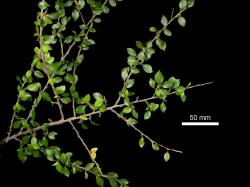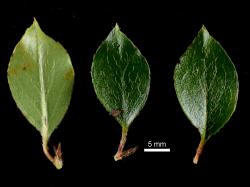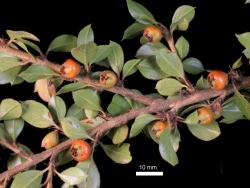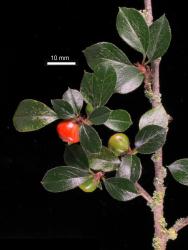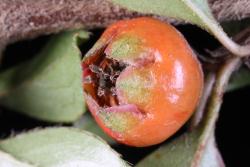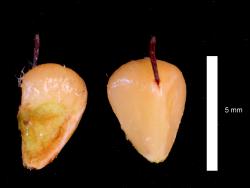Erect shrub 0.6–2.5 m tall, deciduous. Branches horizontal, in flattened planes with herringbone branching; branchlets grey-brown, papillae present at fallen hair bases, branchlet hairs dense, yellow; stipule persistent, 3.5–4.0 mm long, green or red, hairs sparse and white. Leaves sparse to crowded on branches, 22–29 mm long, lamina 18–23 mm long, 8.5–11.0 mm wide, elliptical, plane or slightly V-shaped, 210–240 µm thick, petiole 46 mm long, sparse, white or yellow; leaf base cuneate; leaf apex acute and cuspidate, apiculus straight; lateral veins in 4–5 pairs, midvein only impressed above and projecting below; upper surface smooth to slightly rugose, dark yellowish-green (RHS 139A), glossy, upper-surface hairs sparse, white or yellow; margins plane, hairs sparse to moderately dense, yellow; lower surface not glaucous, glossy, hairs sparse, white or yellow.
Flowers invariably solitary, inflorescence branch 12–20 mm long, rachis hairs dense; pedicel 2.5–3.0 mm long, hairs sparse, white. Flowers 6.0 mm diameter. Hypanthium green, sepals 1.3–1.5 mm long, 2.6–3.0 mm wide, hairs sparse, white. Petals red in bud, when open erect, red centrally, margins white or mixed red and white, 4.0–4.5 mm long, 3.1–3.5 mm wide, base not clawed, glabrous, margins appearing torn. Stamens 20; filaments 1.6–2.6 mm long, white, pink later; anthers white, 1.0–1.2 mm long; styles 3–4, 2.0–2.5 mm long. Fruit very glossy, strong orange (RHS 26A) to vivid reddish-orange (RHS 34A), strongly obovoid, 7.8–8.3 mm long, 7.0–8.9 mm diameter, calyx very open navel, hairs absent except at calyx margins and petiole. Pyrenes 3–4, 4.2–5.3 mm long, 3.6–4.2 mm wide, hairs sparse or none at apex, style attached 1.1–2.0 mm below pyrene apex.
A low shrub, c. 1 m tall, with planar, distichous branching, small leaves and branchlets with yellow strigose hairs, leaf lamina 13 × 9 mm, plane, apex acute to acuminate, stipules persistent and particularly obvious. Flowers solitary, hypanthium with only sparse hairs, petals erect, red centrally, white marginally, anthers white, filaments white turning pink. Fruit orange, strongly obovoid, pendent (more obvious below the plane of the branch), navel very wide open because calyx lobes are erect. Pyrenes 3–4.
Most similar to Cotoneaster simonsii and C. divaricatus. Similar in orange fruit colour and obovoid fruit shape to C. simonsii, and in having an open navel, but differs from C. simonsii in having horizontal branches with a herringbone pattern and smaller leaves.
Very similar in leaf size, shape, and leaf hairs to C. divaricatus, but the leaves of C. marquandii are acute and cuspidate, whereas in C. divaricatus they are obtuse and often cuspidate. Leaves are often smaller: 8.5–11.0 mm wide (8.5–17 mm wide in C. divaricatus). The flowers are very similar: petals erect, red centrally and pink to white marginally, but stamen number is 20, not 11–15 as in C. divaricatus. The most obvious difference is in the fruit: C. marquandii has an orange fruit that resembles that of C. simonsii but has a wider navel. Cotoneaster divaricatus has a red fruit with a closed navel. Pyrenes are 3–4 whereas C. divaricatus has 2(3) pyrenes.
Canterbury (Victoria Park 2013–2016). In cultivation at Abberley Park, Christchurch, 2013–2016).
First listed in this publication.
CHR 635013, D. Glenny 11952, 16 Oct. 2013, Victoria Park, Harry Ell Track. A single plant is on a track margin in an area not now cultivated. It is possible the area was cultivated in the past, but the plant is small (< 1 m tall) and so appears to be only about 10–15 years old. There has been no planting in this area for over 30 years.
Flowering: October to November; Fruiting: March
Tetraploid (Fryer & Hylmö 2009), confirmed with flow cytometry using CHR 638083.



